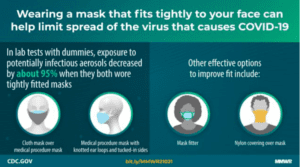Learn more about our FREE COVID-19 Patient Support Program for chronic illness patients and their loved ones.
You already know the drill: Wear a face mask whenever you’re around others who don’t live in your household and practice social distancing (staying six or more feet apart) too. But if you’ve also been doubling up on masks — wearing a medical mask covered by a cloth mask — out of an abundance of caution, research now confirms what you may have guessed: This practice helps protect you better from COVID-19 than wearing only one mask.
In lab tests with dummies, researchers found that exposure to potentially infectious aerosols dropped by about 95 percent when both the source (representing an infected person) and receiver (representing someone standing nearby) wore tightly fitted masks — achieved by either wearing a cloth mask over a medical procedure mask (photo B below) or wearing a medical procedure mask with knotted ear loops and tucked-in sides (photo C below) — compared to no mask at all, according to a new study published in the U.S. Centers for Disease Control and Prevention (CDC) Morbidity and Mortality Weekly Report.
These methods were much more effective than wearing an unknotted procedure mask that left room for gaps around the face (photo A below). Cloth masks and medical procedure masks fit more loosely than respirators like N95 masks, which the CDC still discourages for the general public since they need to be reserved for health care workers.
Double masking or knotting and tucking a medical mask helps it fit to your face better, so infectious particles have a lower chance of escaping or entering your mask.
The study included two experiments: The first observed the effects of exposure via simulated coughing, while the second looked at exposure risk with simulated breathing.
In the first experiment that simulated coughing, the researchers found that:
- Wearing an unknotted medical procedure mask alone blocked 42 percent of the particles from a simulated cough from the source, while wearing a cloth mask alone only blocked 44.3 percent of particles.
- However, wearing a cloth mask over the medical procedure mask (double mask) blocked 92.5 percent of cough particles from the source.
In the second experiment that simulated breathing, the researchers found that:
- Double masking or knotting and tucking a medical procedure mask on the source reduced the cumulative exposure of an unmasked receiver by 82.2 percent and 62.9 percent, respectively.
- When the source was unmasked and the receiver was fitted with either a double mask or the knotted and tucked mask, the receiver’s cumulative exposure was reduced by 83 percent and 64.5 percent, respectively.
- Finally, when the source and the receiver were both fitted with double masks or knotted and tucked masks, the cumulative exposure of the receiver was reduced by 96.4 percent and 95.9 percent, respectively.
“The extent to which [face masks] reduce exhalation and inhalation of particles in the aerosol size range varies substantially, in part because air can leak around their edges, especially through the side gaps,” note the researchers. “This observation suggests that modifications to improve fit might result in equivalent improvements, regardless of the masks’ baseline filtration efficiencies.”
In other words, wearing any mask will protect you much better than not wearing one. However, well-fitting masks block emitted aerosols and their exposure to others the best, and the protection occurs greatest when everyone is wearing a well-fitted mask.
Related research has found placing a sleeve made from sheer nylon hosiery material around the neck and over a cloth or medical procedure mask may also improve the fit (and therefore the protection) of the mask. Solid or elastic fitters may also be worn over the mask to help reduce gaps in cloth and medical procedure masks.
Fourteen states and the District of Columbia had universal masking mandates as of February 1, 2021. Masks are also now required on planes, buses, trains, and other public transportation in the United States.
To make sure your mask fits properly, the CDC recommends:
- Choose a mask with a wire you can bend over your nose to fit it closely to your face (this prevents air from leaking out from the top of the mask).
- Use a mask fitter or brace over your disposable or cloth mask to prevent air leakage around the edges.
- Make sure no air flows out from near your eyes or the sides of the mask — if the mask fits well, you’ll feel warm air coming through the front of the mask and may be able to see the mask move in and out as you breathe.
- Pick a mask that has multiple layers of fabric or wear one disposable mask underneath a cloth mask, so that the cloth mask pushes the edges of the disposable one against your face.
- Knotting the ear loops of a 3-ply face mask at the edge of the mask and folding and tucking the unneeded material under the edges (here’s a video on how to do it).
The CDC advises against combining two disposable masks, since they’re not designed to fit tightly and wearing more than one will not improve the fit. If you do have a KN95 mask, don’t wear it with any other mask — those should be used alone.
Get Free Coronavirus Support for Chronic Illness Patients
Join the Global Healthy Living Foundation’s free COVID-19 Support Program for chronic illness patients and their families. We will be providing updated information, community support, and other resources tailored specifically to your health and safety. Join now.
Brooks J, et al. Maximizing Fit for Cloth and Medical Procedure Masks to Improve Performance and Reduce SARS-CoV-2 Transmission and Exposure, 2021. Morbidity and Mortality Weekly Report. February 10, 2021. doi: http://dx.doi.org/10.15585/mmwr.mm7007e1.
Improve How Your Mask Protects You. COVID-19. U.S. Centers for Disease Control and Prevention. February 10, 2021. https://www.cdc.gov/coronavirus/2019-ncov/your-health/effective-masks.html.
Pro Tip to Help Your Earloop Mask Fit More Tightly. UNC Health/YouTube. October 8, 2020. https://www.youtube.com/watch?v=UANi8Cc71A0&feature=youtu.be.








